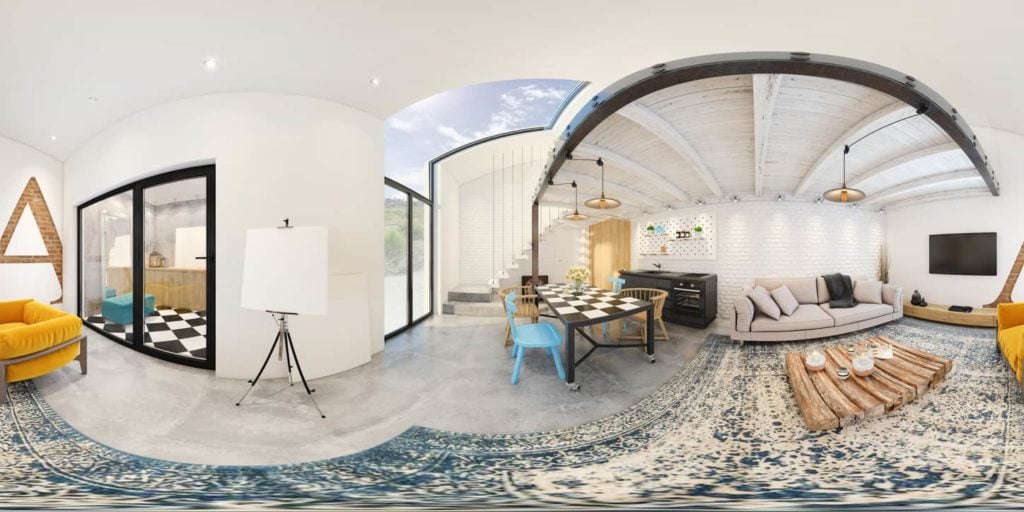It’s a well-worn cliché to say that “a picture is worth more than 1,000 words.” Studies have shown that a single minute of video is worth 1.8 million words. But if that’s true for linear video, then where does the number go for interactive content? We’ve often touted the power of 360-degree virtual experiences, and for good reason.
Immersing your audience in content about you with which they can interact tends to increase their engagement, recall, and brand awareness. The good news: we’re not just saying that because of the product we offer. Studies increasingly agree that by going beyond linear video, marketers can gain significant benefits for their brand and business.
So let’s dig in. Below, we’ll examine some of the available research on the topic of linear vs. interactive video, before going deep on how you can implement 360-degree virtual experiences to benefit your business.
First Things First: What is Interactive Video?
We’ll begin with a basic definition. As its name suggests, interactive content is any type of content in which the audience has the opportunity to customize or change the direction of the content. The same is true for video.
In linear videos, users click play and watch the content unfold. The only choice they have is whether to watch it through to the end. But with interactive video, those choices multiple. Users can drag or click their mouse, move to different segments, or even use their phone’s motions to adjust the video based on their preferences.
This interaction makes this type of content much more similar to dynamic web or other digital content than video typically is. The audience is given a greater degree of control to customize how they want to experience it. The benefits, research suggests, are immense.
Why Interactive Content Beats Linear Video
What are the core goals you want to get out of your video strategy? Chances are that the answer includes any or all of the below:
- Increase brand and product awareness.
- Define your positioning within a competitive market.
- Improve engagement with your audience.
- Close the deal and turn those paying attention into customers.
There’s a reason that video marketing, at its core, revolves around these four bullet points. As a medium, it’s exceptionally positioned to accomplish them. But here’s the thing: while linear video is good as a means to accomplish these and similar goals, research suggests that interactive video has it beat in almost every metric.
At its most basic, interactive video almost universally boosts viewing time. One study found that audiences spent 44% more time watching interactive videos than linear ones. According to another, that time increase is a statistically identical 47%.
When they’re spending more time with it, audiences also tend to interact more. That’s why, according to one source, audiences are three times more likely to engage with the content. Another found click-through rates of 20%, compared to the average 1% to 2% for linear video (a cool 10x increase).
In short, viewers watch more and interact more. It probably doesn’t come as a surprise, then, that their ability to recall the brands using this type of content also increases dramatically. In fact, according to one study using interactive video from Amazon, Arby’s, and other national brands, brand recall increased by 32% even among viewers who didn’t interact with the video itself.
Put all of that research together, and you have a reliable recipe for marketing success. It’s probably no surprise, then, that 78% of marketers who use interactive video consider it to be highly effective in reaching their goals and engaging their audience.
How to Implement Interactive Videos That Satisfy Your Engagement-Hungry Audiences
The research is clear. But what does that mean for your own business? Benefits don’t result in positive ROI or business outcomes if you cannot implement them. In other words, you need a defined plan for how to build 360 virtual experiences that satisfy and engage your audience.
Step 1: Find the Right Spot
First, that means understanding exactly what your business can actually show off. In other words, what visuals would your audience benefit from to not just see, but also interact with? Depending on your industry, that could result in several answers:
- In higher education, hot spots on campus (such as your library, your newest academic building, a residence hall, your dining hall, or a popular hangout spot) tend to be a safe bet.
- For hospitality, your lobby, or any common areas (such as your fitness center) lend themselves well to an interactive experience.
- In corporate recruiting, your office spaces and social spaces are relevant for employees looking to decide whether your current job openings are the right fit for them.
The list goes on. Once you’ve identified your best spaces to show off and engage with, start planning the video.
Step 2: Choose Your Interaction Type
Most importantly, you’ll need to determine exactly how audiences would interact with the video. In other words, how can you build content that is significantly different from a more linear alternative? Interactive possibilities include:
- 360-degree views, allowing the audience to virtually “look around.” The key to success here is making sure you choose an area and vantage point that looks great regardless of the perspective and viewpoint.
- Hot spots within your video, which your audience can click on for more information even before the video is complete. For instance, a hot spot in your office space can tell potential employees more about your company culture and benefits.
- “Choice points” within your video, where choosing one of a limited set of options leads to a different video continuation or ending. This is complex to produce but can help tailor your message to your audience.
- In-screen calls to action and forms through which your audience can choose to take a natural next step or leave their contact information for further follow-up. Moving these CTAs into the video itself reduces friction for your audience and tends to increase conversion rates.
Each of these options will likely require a different implementation path, and going deep on each goes beyond the scope of this guide. That said, the key here is making sure you know exactly how your audience should be able to interact with your video to maximize your chances of reaching your marketing goals.
Step 3: Build Your Video Production Plan and Platform
With the location and interaction type in place, it’s time to make sure that you can execute your goals. That means having the production capacity and capability to turn around the video assets, but also ensuring that you have a platform specifically designed for interaction.
Plenty of those platforms exist. YouTube, for instance, can now host 360 virtual experiences. Vimeo offers many of the other interaction opportunities mentioned above.
This step is about the resources. It’s important as a third step because you can tailor your resources specific to your strategic marketing needs and goals. Ideally, by the time this step is complete, you have a good idea of how you’ll exercise the video.

Step 4: Integrate Your Interactive Video Into Your Marketing Strategy
Once your new, interactive video experience is created, it’s time to make sure it maximizes its potential. That means integrating it within a larger strategy designed to build audience awareness, engagement, and conversions.
At its most simple, this type of integration means ensuring that your interactive video content is prominently highlighted on your website, social media, and other digital channels. At the very least, in other words, you have to make sure that your audience can find it easily to leverage its potential.
Ideally, though, marketing integration goes beyond that first step. For instance, creating single 360-degree videos is a great first step. But what if you could also combine these individual videos into a more comprehensive, immersive interactive experience?
That step undoubtedly adds complexity to the process. But it also maximizes your chances of making sure that your audience will make the most out of the opportunity to engage with your content in a way that benefits your marking strategy.
Ready to Build Your Own 360 Virtual Experiences?
In short, interactive video has the potential for immense success. Especially in a digital environment of increasing noise and decreasing attention span, it might be the spark your audience needs to interact with, and recall, your brand content above that of your competition. But you need to get it right.
Often, that means finding a partner who can help you. After all, there are few video experts and especially interactive video experts available. The ideal partner, in turn, differs based on anything from your audience to the type of interactive video you want to create.
Concept3D, for instance, specializes in virtual tours created through individual 360 virtual experiences. If that type of interaction makes sense for you, we’d love to partner. If you’re looking for other types of immersion, other partners may make more sense. But who knows? We might be the perfect fit for your marketing needs. Contact us to find out.

